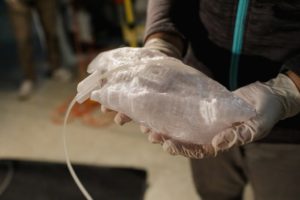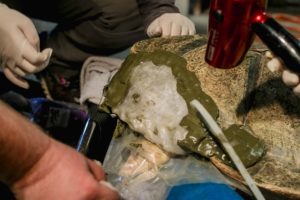UCSD Helps Preserve Sea Turtle’s Health with 3D Printed Brace
 In 2013, a young loggerhead sea turtle was found in the cooling canal of a New Jersey power plant. She had several physical problems when she was found – there was a gap in the bottom right part of her shell, her back flippers were paralyzed, and she had a case of scoliosis. Because of these issues, it was quickly determined that she would never be able to survive in the wild, so she was ultimately sent to Birch Aquarium at Scripps Institution of Oceanography, UC San Diego. When she arrived, the turtle weighed only 74.5 pounds, but she has done wonderfully in her new home, gaining more than 130 pounds.
In 2013, a young loggerhead sea turtle was found in the cooling canal of a New Jersey power plant. She had several physical problems when she was found – there was a gap in the bottom right part of her shell, her back flippers were paralyzed, and she had a case of scoliosis. Because of these issues, it was quickly determined that she would never be able to survive in the wild, so she was ultimately sent to Birch Aquarium at Scripps Institution of Oceanography, UC San Diego. When she arrived, the turtle weighed only 74.5 pounds, but she has done wonderfully in her new home, gaining more than 130 pounds.
Unfortunately, that growth, while healthy, has caused some problems for the turtle.
Geisel Library is heavily invested in innovative technology, according to Scott McAvoy, who runs the Digital Media Lab (DML). The lab provides free 3D services to the UCSD community, and was happy to help design a brace for the turtle.“That growth has really exacerbated her condition. Without our intervention, the sea turtle could have gastro-intestinal and urogenital systems complications,” said Jenn Nero Moffatt, Senior Director of Animal Care, Science and Conservation for the aquarium. “We teamed up with the Digital Media Lab at Geisel Library to create a brace that will prevent the shell from curving further downward and will promote more normal growth. It’s our goal to prevent further complications and keep her as healthy and happy as possible.”
Since the turtle arrived at UC San Diego, she has been CT scanned twice at the university’s Thornton Hospital to monitor any changes in her shell. Those scans were combined with 3D scans taken by the team and used to design a brace that is perfectly fitted to the turtle’s shell, keeping it from further curving and allowing her to move unencumbered.
“I used a Prusa i3 MK2 to prototype in PLA, then the final project was printed with PETG and PETT on the Ultimaker 2+ with a .8mm nozzle and huge .6mm layers height to try to maximize transparency. The model was made using Agisoft Photoscan and Autodesk Meshmixer. It was really surprising how well everything fit from the start. We took a photo scan of the turtle shell, flipped the healthy half over the gap, and subtracted the bad half to create a perfectly form fitting plug,” McAvoy told 3DPrint.com.
“We ended up scooping out the bottom to allow a wider range of movement and reduce contact with soft tissue. One of the biggest challenges was designing a system to provide a constant downward pressure on the brace to help keep shape while the turtle grows. I scrapped a bunch of concepts and finally realized that zip ties would work better than anything I could conceive of, so we built clips to hold a big 9mm zip tie system.”
A Velcro neoprene weight pocket was also added to provide neutral buoyancy as the turtle rests. Everything was adhered with a safe marine epoxy.
Sea turtles can grow to be quite large – this particular turtle may grow to as much as 250 pounds, so she’s likely going to outgrow her brace. When that happens, the team will simply scale up the design and 3D print her a larger one, as the technology continues to prove adaptable to help turtles and other animals on the path to health.
“This is truly an ocean rehabilitation success story,” said Moffatt. “As a member of the AZA, Birch Aquarium is committed to conserving, rehabilitating and protecting animals in threat of extinction. It’s exciting that we are able to use technology in this unique way so our Loggerhead Sea Turtle can continue her role as ambassador for ocean conservation, greeting more than 450,000 visitors each year.”
Those visitors can see the turtle in the aquarium’s Hall of Fishes’ Magdalena Bay exhibit. Every Tuesday and Thursday at 2:30 PM they can watch her being trained and fed, and see the 3D printed brace that is keeping her swimming happily and healthily thanks to the hard work of the UCSD team.
Discuss this and other 3D printing topics at 3DPrintBoard.com or share your thoughts below.
[Images/video provided by UCSD]
Subscribe to Our Email Newsletter
Stay up-to-date on all the latest news from the 3D printing industry and receive information and offers from third party vendors.
Print Services
You May Also Like
3D Printing Financials: Prodways Ends 2024 with a Profit
After a tough couple of years, Prodways (EPA: PWG) is starting to bounce back. The French 3D printing company finally made a profit in 2024, improved its operating performance, and...
Blue Origin & Auburn University Use EOS M290 to Study Copper 3D Printing
Blue Origin, the commercial space company built off of investments from Amazon founder Jeff Bezos, has donated two EOS M290 powder bed fusion (PBF) printers to Auburn University’s National Center...
Rocket Lab to Acquire Restructured Laser Communications Provider Mynaric AG
Rocket Lab USA, the Long Beach-based, end-to-end space services company that specializes in producing rockets with additive manufacturing (AM), has announced plans to acquire Mynaric AG, a German provider laser...
3D Printing Financials: Stratasys Ends 2024 with Cost Cuts and Growth Plans
Stratasys (Nasdaq: SSYS) has wrapped up 2024 with stronger margins but a full-year net loss. The polymer 3D printing leader navigated a year of economic headwinds, restructuring efforts, and shifting...
































